![]()
![]()
![]()
Use LEFT and RIGHT arrow keys to navigate between flashcards;
Use UP and DOWN arrow keys to flip the card;
H to show hint;
A reads text to speech;
222 Cards in this Set
- Front
- Back
|
What is the Required Practical associated with Antibiotics? |
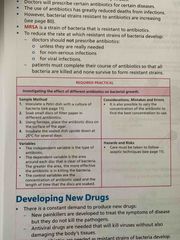
Back (Definition) |
|
|
What does a Plant Cell contain? |
•Nucleus •Cytoplasm •Cell Membrane •Mitochondria •Ribosomes •Cell Walls •Permanent Vacuole •Chloroplasts |
|
|
What is the role of the Nucleus? |
It controls the activities of the Cell, and contains the Genetic Material. |
|
|
What happens in the Cytoplasm? |
Most chemical reactions take place. |
|
|
What does the Cell Membrane do? |
Controls the passage of substances in and out of the Cell. |
|
|
What happens in the Mitochondria? |
Aerobic Respiration. |
|
|
What happens in the Ribosomes? |
Proteins are synthesised (made). |
|
|
What is a Cell Wall? |
A substance made of Cellulose which strengthens the Cell. |
|
|
What is a Permanent Vacuole? |
A substance made from Cell Sap which supports the Plant. |
|
|
What is the role of Chloroplasts? |
To absorb light in order to make food in the form of Glucose. This process is called Photosynthesis. |
|
|
What are the two main types of Cell? |
•Prokaryotic •Eukaryotic |
|
|
Give some examples of Eukaryotic Cells. |
•Plant Cells •Animal Cells •Fungal Cells |
|
|
Give an example of Prokaryotic Cells. |
•Bacterial Cells |
|
|
What are the differences between Prokaryotic and Eukaryotic Cells? |
•Prokaryotic Cells are much smaller in size. •Prokaryotic Cells do not have their Genetic Material enclosed in a Nucleus. •Prokaryotic Cells Genetic Material is a single DNA loop (Plasmid). •Prokaryotic Cells don’t contain Mitochondria or Chloroplasts. |
|
|
What do Plasmids allow? |
Bacterial Cells to move Genes from one Cell to another. |
|
|
What does a Typical Bacterial Cell contain? |
•Plasmid DNA •Chromosomal DNA •Flagella •A Cell Wall •A Cytoplasm |
|
|
What does a Typical Bacterial Cell contain? |
•Plasmid DNA •Chromosomal DNA •Flagella •A Cell Wall •A Cytoplasm |
|
|
What is Plasmid DNA? |
A small section of DNA that can replicate independently of Chromosomal DNA. |
|
|
What is Chromosomal DNA? |
DNA of Bacteria not found within a Nucleus. It is found as one Circular Chromosome. |
|
|
What are Flagella? |
Tail-like structures that rotate to help some Bacteria move. |
|
|
What is the Required Practical associated with Investing Cells? |
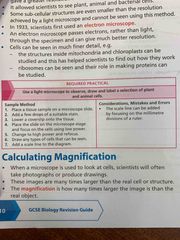
Back (Definition) |
|
|
How big is the typical Plant Cell? |
0.1mm in diameter. |
|
|
How big is the typical Animal Cell? |
0.02mm in diameter. |
|
|
Define Resolution. |
The ability to see two or more objects as separate objects. |
|
|
When was the Light Microscope developed? |
In the late 16th century. It gave greater resolution than the human eye. |
|
|
When was the Electron Microscope developed? |
1933 and it gave a much greater resolution. |
|
|
Define Magnification. |
How many times larger the Image is than the Real Object. |
|
|
What is the equation for Magnification? |
Size of Image / Size of Real Object |
|
|
What is Binary Fission? |
A type of Cell Division? |
|
|
When using Binary Fission hoe often can Bacteria multiply? |
Every 20 Mins. |
|
|
What is Agar? |
A type of Jelly. |
|
|
What is a Culture? |
A substance that provides the nutrients for the artificial growth of Bacteria and other cells. |
|
|
What does the Nucleus contain? |
Chromosomes made of DNA. |
|
|
What are Genes? |
Part of a Chromosome, made of DNA, which codes for a protein. |
|
|
What does the Nucleus contain? |
Chromosomes made of DNA. |
|
|
What are Genes? |
Part of a Chromosome, made of DNA, which codes for a protein. |
|
|
What is the Cell Cycle? |
When Cells go through a series of changes involving Growth and Division. |
|
|
What happens in Mitosis? |
1) One set of Chromosomes is pulled to each end of the Cell. 2) The Nucleus divides. 3) The Cytoplasm and Cell Membranes divide to form two identical Cells. |
|
|
What are Undifferentiated Stem Cells? |
Stem Cells that haven’t become specialised. |
|
|
Why are Undifferentiated Stem Cells beneficial? |
They can help in the Growth and Repair of Cells. |
|
|
What is the disadvantage of Adult Stem Cells? |
They can only make certain types of Cells and their capacity to divide is limited. Whereas Embryonic Stem Cells do not suffer from these characteristics. |
|
|
What are Undifferentiated Stem Cells? |
Stem Cells that haven’t become specialised. |
|
|
Why are Undifferentiated Stem Cells beneficial? |
They can help in the Growth and Repair of Cells. |
|
|
What is the disadvantage of Adult Stem Cells? |
They can only make certain types of Cells and their capacity to divide is limited. Whereas Embryonic Stem Cells do not suffer from these characteristics. |
|
|
Why are Stem Cells useful? |
In treating conditions where Cells are damaged or not working properly such as Diabetes and Paralysis. |
|
|
What is Therapeutic Cloning? |
When a Cloned Embryo of the patient is made and used as a source of Stem Cells. |
|
|
What are Undifferentiated Stem Cells? |
Stem Cells that haven’t become specialised. |
|
|
Why are Undifferentiated Stem Cells beneficial? |
They can help in the Growth and Repair of Cells. |
|
|
What is the disadvantage of Adult Stem Cells? |
They can only make certain types of Cells and their capacity to divide is limited. Whereas Embryonic Stem Cells do not suffer from these characteristics. |
|
|
Why are Stem Cells useful? |
In treating conditions where Cells are damaged or not working properly such as Diabetes and Paralysis. |
|
|
What is Therapeutic Cloning? |
When a Cloned Embryo of the patient is made and used as a source of Stem Cells. (These Stem Cells will not be rejected by the patients body) |
|
|
What are the concerns about using Cloned Embryo Cells? |
•There may be risks such as the transfer of viral infection. •There may have ethical or religious objections. |
|
|
What are Meristems? |
Special areas in plants, stem cells are found. They allow plants to produce clones quickly. |
|
|
Why are Meristems useful? |
•To protect rare species of plants from extinction. •Large numbers of identical crop plants with special features such as disease resistance. |
|
|
What is Diffusion? |
The Net Movement of Particles that move from an area of higher concentration to an area of lower concentration until they are evenly spread out. |
|
|
State some examples of Diffusion in living organisms. |
•Oxygen & Carbon Dioxide diffuse during gas exchange. •Urea diffuses from Cells into the blood plasma for excretion by the kidney. •Digested food molecules from the small intestine diffuse into the blood. |
|
|
What factors affect the rate of Diffusion. |
•The Concentration Gradient •The Temperature •The surface area of the membrane. |
|
|
What type of Organism has a large Surface Area to Volume ratio? |
A Single-Celled Organism. |
|
|
What is Osmosis? |
When water moves across Cell Membranes. (The Diffusion of water from a dilute solution to a concentrated solution). |
|
|
What is the Required Practical associated with Transport In and Out of Cells? |
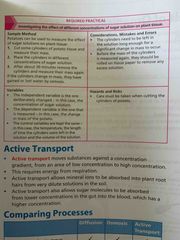
Back (Definition) |
|
|
What type of Organism has a large Surface Area to Volume ratio? |
A Single-Celled Organism. |
|
|
What is Osmosis? |
When water moves across Cell Membranes. (The Diffusion of water from a dilute solution to a concentrated solution). |
|
|
What is the Required Practical associated with Transport In and Out of Cells? |
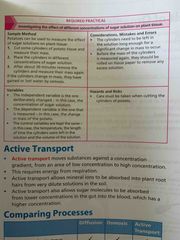
Back (Definition) |
|
|
What is Active Transport? |
Moving substances against a concentration gradient, from an area of low concentration to high concentration. |
|
|
COMPARING TRANSPORT PROCESSES |
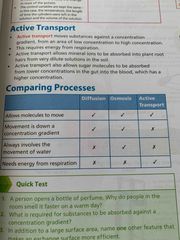
Back (Definition) |
|
|
What are Specialised Cells? |
Cells which have differentiated to form another type of Cell. |
|
|
What may happen when a Cell differentiates? |
•It may change shape. •It may have different Sub-Nuclear structures develop, which enables the Cell to carry out a specific function. |
|
|
EXAMPLES OF SPECIALISED CELLS |
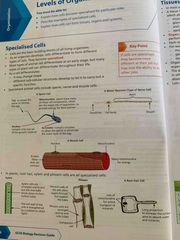
Back (Definition) |
|
|
Define Tissue. |
A group of Cells that have a similar structure and function. |
|
|
What are Organs? |
Groups of different Tissues, which work together to form a specific job. |
|
|
What are Organ Systems? |
A group of Organs which work to do a particular job. |
|
|
What are Enzymes? |
Biological Catalysts. |
|
|
What are the properties of Enzymes? |
•They are all large proteins. •There is a space within the protein molecule called the Active Site. •Each Enzyme catalyses a Specific reaction. •They work best at a specific temperature and pH called the Optimum. |
|
|
What is the Lock and Key Theory? |
A model used to explain how Enzymes work. The chemical that reacts is called the Substrate (Key) and it fits into the Enzyme’s Active Site (Lock). |
|
|
What is Denaturing? |
When high temperatures and extreme pHs make Enzymes change shape. |
|
|
Once an Enzyme is Denatured, is it still functional? |
No, it cannot work because the Substrate cannot got into the Active Site. |
|
|
How are Digestive Enzymes produced? |
1)The Enzymes Pass out of the Cells and into the Digestive System. 2)They come into contact with food Molecules. 3)They catalyse the breakdown of large insoluble food Molecules into smaller soluble Molecules. |
|
|
What is Denaturing? |
When high temperatures and extreme pHs make Enzymes change shape. |
|
|
Once an Enzyme is Denatured, is it still functional? |
No, it cannot work because the Substrate cannot got into the Active Site. |
|
|
How are Digestive Enzymes produced? |
1)The Enzymes Pass out of the Cells and into the Digestive System. 2)They come into contact with food Molecules. 3)They catalyse the breakdown of large insoluble food Molecules into smaller soluble Molecules. |
|
|
Name the three Digestive Enzymes and their functions. |
•Protease (breaks down proteins). •Lipase (breaks down lipids (fats and oils)). •Carbohydrase (breaks down carbohydrates. They all help to produce smaller Molecules which can be easily absorbed into the bloodstream. |
|
|
What is Denaturing? |
When high temperatures and extreme pHs make Enzymes change shape. |
|
|
Once an Enzyme is Denatured, is it still functional? |
No, it cannot work because the Substrate cannot got into the Active Site. |
|
|
How are Digestive Enzymes produced? |
1)The Enzymes Pass out of the Cells and into the Digestive System. 2)They come into contact with food Molecules. 3)They catalyse the breakdown of large insoluble food Molecules into smaller soluble Molecules. |
|
|
Name the three Digestive Enzymes and their functions. |
•Protease (breaks down proteins into Peptides and Amino Acids). •Lipase (breaks down lipids (fats and oils into Fatty Acids and Glycerol). •Carbohydrase (breaks down carbohydrates into Starch). They all help to produce smaller Molecules which can be easily absorbed into the bloodstream. |
|
|
What is the Required Practical associated with Enzymes in Digestion? |
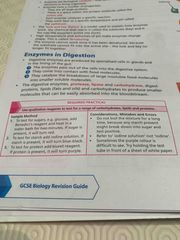
Back (Definition) |
|
|
What is the Required Practical associated with Bile and Digestion? |
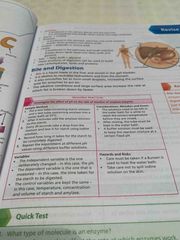
Back (Definition) |
|
|
What are Amylase? |
A Carbohydrase (produced in the Salivary Glands and the Pancreas) that breaks down Starch into sugar. |
|
|
What are Protease? |
A Digestive Enzyme (produced in the stomach, pancreas and small intestine) which breaks down proteins into Peptides and Amino Acids. |
|
|
What is Lipase? |
A Digestive Enzyme (that is produced in the pancreas and small intestine) which helps to break down lipids into Fatty Acids and Glycerol. |
|
|
What is Bile? |
A liquid made in the liver and stored in the gall bladder. It is used to neutralise the Hydrochloric Acid in the stomach. |
|
|
What is Plasma made up of? |
•Red Blood Cells •White Blood Cells •Platelets |
|
|
What is Plasma? |
A clear fluid part of the blood that contains dissolved substances such as proteins and mineral ions. |
|
|
What does Plasma do? |
Transports various chemical substances (like hormones, antibodies, urea and carbon dioxide) around the body. |
|
|
Describe the properties of a Red Blood Cell? |
•They contain Haemoglobin. •They don’t contain a Nucleus so there’s more room for Haemoglobin. •They are very small, and so they can fit through the tiny Capillaries. •They are shaped like Biconcave Discs, giving them a larger surface area that oxygen can quickly Diffuse across. |
|
|
What is Haemoglobin? |
A red pigment in Red Blood Cells, that carries oxygen to the Organs. |
|
|
Describe the properties of White Blood Cells? |
•They help to protect the body against the infection. •They can change shape, so they can squeeze out of the blood vessels into tissues in order to surround and engulf microorganisms. |
|
|
What are Platelets? |
Fragments of Cells which collect at wounds and trigger blood clotting (in order to make a scab). |
|
|
What are the three types of Blood Vessels? |
•Arteries •Veins •Capillaries |
|
|
What are Arteries? |
A type of Blood Vessel which transports Blood from your Heart to your Organs. They have thick walls made from muscle and elastic fibres. |
|
|
What are Veins? |
A type of Blood Vessel which transports Blood from your Organs to your Heart. They have thin walls and valves to prevent back-flow. |
|
|
What are Capillaries? |
A type of Blood Vessel which allows substances needed by the Cells to pass out of the Blood, and it allows substances produced by the Cells to pass into the Blood. They are narrow and have thin walls. |
|
|
What is a Double Circulatory System? |
The type of Blood System found in mammals, where the Blood goes through the Heart twice on each circuit of the body. |
|
|
What are the four Chambers of the Heart? |
•The left and right Atria. •The left and right Ventricles. |
|
|
What are the Atria? |
The upper Chambers of the Heart, which receive Blood from the Veins. |
|
|
What are the Ventricles? |
The lower two Chambers of the Heart. |
|
|
DIAGRAM OF THE FLOW OF BLOOD INTO THE HEART |

Back (Definition) |
|
|
Describe the process of which Deoxygenated Blood the Right Atrium and then exists the Left Ventricle as Oxygenated Blood. |
1)Deoxygenated Blood enters the Right Atrium, through the Vena Cava. 2)The Right Atrium contracts and forces the Blood into the Right Ventricle. 3)The Right Ventricle contracts and forces the Blood out of the Heart and into the Pulmonary Artery. 4)The Pulmonary Artery pumps the Blood to the Lungs, where the Oxygen binds to the Haemoglobin. 5)The Pulmonary Vein returns the now Oxygenated Blood to the Left Atrium. 6)The Left Atrium contracts and forces the Blood into the Left Ventricle. 7)The Left Ventricle contracts and forces Blood out of the Heart via the Aorta. |
|
|
What is a Natural Pacemaker? |
A group of Cells located in the Right Atrium that control Heart Rate. |
|
|
What is an Artificial Pacemaker? |
An electronic device used to correct irregularities in the Heart Rate. |
|
|
What is the purpose of the Valves on the Heart? |
To prevent the back-flow of Blood. |
|
|
Describe the Gaseous Exchange. |
1)The Heart sends Blood to the Lungs via the Pulmonary Artery. 2)Oxygen is transported from the Mouth to the Lungs through the Trachea (Windpipe). 3)The Trachea divides into two tubes (the Bronchi). 4)The Bronchi divide into Bronchioles. 5) The Bronchioles divide until they end with Alveoli. 6) The Blood is Oxygenated then transported back to the Heart through the Pulmonary Vein. |
|
|
What is a Natural Pacemaker? |
A group of Cells located in the Right Atrium that control Heart Rate. |
|
|
What is an Artificial Pacemaker? |
An electronic device used to correct irregularities in the Heart Rate. |
|
|
What is the purpose of the Valves on the Heart? |
To prevent the back-flow of Blood. |
|
|
Describe the Gaseous Exchange. |
1)The Heart sends Blood to the Lungs via the Pulmonary Artery. 2)Oxygen is transported from the Mouth to the Lungs through the Trachea (Windpipe). 3)The Trachea divides into two tubes (the Bronchi). 4)The Bronchi divide into Bronchioles. 5) The Bronchioles divide until they end with Alveoli. 6) The Blood is Oxygenated then transported back to the Heart through the Pulmonary Vein. |
|
|
Define Alveoli and their properties. |
•They are tiny air sacs. •They have a large, moist surface area. •They have a very rich Blood Supply. •They are very close to the Blood Capillaries, so the distance for the gases to Diffuse is small. |
|
|
Define Good Health. |
A state of physical and mental well-being. |
|
|
Define Disease. |
A malfunction/infection of the body. |
|
|
What are the two main types Disease? |
•Communicable Diseases. •Non-Communicable Diseases. |
|
|
What is a Communicable Disease? |
A Disease which can be spread between Organisms. |
|
|
What is a Non-Communicable Disease? |
A Disease that cannot be spread between Organisms. |
|
|
List some examples of Diseases which interact with each other. |
•Viruses infecting Cells can be the trigger of Cancer. •Diseases of the Immune System mean that an individual is more likely to catch an infectious Disease. •Immune reactions triggered by a Pathogen can cause Allergic Reactions. •Physical Illness may lead to Mental Illness. •Poor Diet, stress and poor Mental Health can increase your likely good of catching certain Diseases. |
|
|
Define Good Health. |
A state of physical and mental well-being. |
|
|
Define Disease. |
A malfunction/infection of the body. |
|
|
What are the two main types Disease? |
•Communicable Diseases. •Non-Communicable Diseases. |
|
|
What is a Communicable Disease? |
A Disease which can be spread between Organisms. |
|
|
What is a Non-Communicable Disease? |
A Disease that cannot be spread between Organisms. |
|
|
List some examples of Diseases which interact with each other. |
•Viruses infecting Cells can be the trigger of Cancer. •Diseases of the Immune System mean that an individual is more likely to catch an infectious Disease. •Immune reactions triggered by a Pathogen can cause Allergic Reactions. •Physical Illness may lead to Mental Illness. •Poor Diet, stress and poor Mental Health can increase your likely good of catching certain Diseases. |
|
|
What are Risk Factors? Give an example of one. |
A factor that wills increase the chance of developing a Disease. For example a persons lifestyle choices. |
|
|
What is Casual Mechanism? |
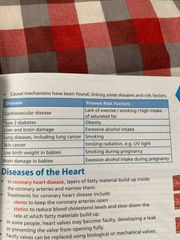
A factor that makes a Disease more likely to occur. |
|
|
What occurs Coronary Heart Disease? |
Layers of fatty material builds up in the Coronary Arteries. |
|
|
List the two treatments of Coronary Heart Disease. |
•Stents (Keeps Coronary Arteries open). •Statins (Reduces Blood Cholesterol levels, which slows down the rate of production of fatty materials). |
|
|
What treatments are there for Heart Failure? |
•A Donor Heart can be transplanted. •Artificial Hearts can be used to keep patients alive while waiting for a Heart transplant/waiting for the Heart to recover. |
|
|
What treatments are there for Heart Failure? |
•A Donor Heart can be transplanted. •Artificial Hearts can be used to keep patients alive while waiting for a Heart transplant/waiting for the Heart to recover. |
|
|
What are the available treatments for faulty Heart Valves? |
Replacement: •Biological Valves •Mechanical Valves |
|
|
What are Tumours? |
Masses of Cells. |
|
|
What are the two main types of tumour? |
•Benign Tumours (don’t spread around the body). •Malignant Tumours (spread in the Blood to different parts of the body where they form Secondary Tumours). |
|
|
What treatments are there for Heart Failure? |
•A Donor Heart can be transplanted. •Artificial Hearts can be used to keep patients alive while waiting for a Heart transplant/waiting for the Heart to recover. |
|
|
What are the available treatments for faulty Heart Valves? |
Replacement: •Biological Valves •Mechanical Valves |
|
|
What are Tumours? |
Masses of Cells. |
|
|
What are the two main types of tumour? |
•Benign Tumours (don’t spread around the body). •Malignant Tumours (spread in the Blood to different parts of the body where they form Secondary Tumours). |
|
|
What are the different types of Plant Tissues and their functions? |
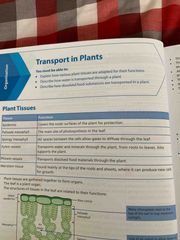
Back (Definition) |
|
|
DIAGRAM OF THE STRUCTURES OF TISSUES IN A LEAF. |
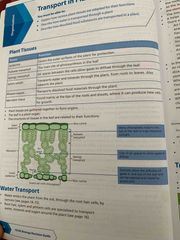
Back (Definition) |
|
|
Describe the Water Transport process in a plant. |
1)Water (contains Dissolved Minerals) enters the plant from the soil through the Root Hair Cells, by Osmosis. 2)The Water and Minerals are transported up the Xylem Vessels from the Roots to the Stems and Leaves. 3)At the Leaves most of the water will Evaporate and Diffuse our of the Stomata (This process is called Transpiration). |
|
|
What treatments are there for Heart Failure? |
•A Donor Heart can be transplanted. •Artificial Hearts can be used to keep patients alive while waiting for a Heart transplant/waiting for the Heart to recover. |
|
|
What are the available treatments for faulty Heart Valves? |
Replacement: •Biological Valves •Mechanical Valves |
|
|
What are Tumours? |
Masses of Cells. |
|
|
What are the two main types of tumour? |
•Benign Tumours (don’t spread around the body). •Malignant Tumours (spread in the Blood to different parts of the body where they form Secondary Tumours). |
|
|
What are the different types of Plant Tissues and their functions? |
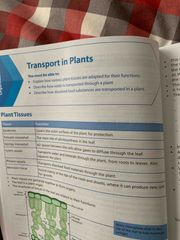
Back (Definition)
|
|
|
DIAGRAM OF THE STRUCTURES OF TISSUES IN A LEAF. |
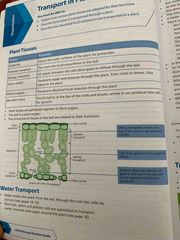
Back (Definition) |
|
|
Describe the Water Transport process in a plant. |
1)Water (contains Dissolved Minerals) enters the plant from the soil through the Root Hair Cells, by Osmosis. 2)The Water and Minerals are transported up the Xylem Vessels from the Roots to the Stems and Leaves. 3)At the Leaves most of the water will Evaporate and Diffuse our of the Stomata (This process is called Transpiration). |
|
|
What factors affect the rate of Transpiration? |
•An increase in Temperature will increase the rate. •Faster Air Flow will increase the rate as it will blow away Water Vapour allowing more to Evaporate. •An increase in Light Intensity will increase the rate as it will cause the Stomata to open. •An increase in Humidity will decrease the rate as the air contains more Water Vapour. |
|
|
What is Translocation? |
The movement of food through Phloem Tissue. |
|
|
What are Pathogens? |
Microorganisms that cause Communicable Disease. |
|
|
How can you prevent the spread of Communicable Diseases? |
•Simple hygiene measures e.g washing hands. •Destroying Vectors. •Isolating infected individuals. •Giving people a t risk a Vaccination. |
|
|
What are Vectors? |
Organisms that carry and pass on the Pathogen without getting the Disease. |
|
|
What is a Virus? |
An infective agent that typically consists of a nucleic acid molecule in a protein coat, is too small to be seen by light microscopy, and is able to multiply only within the living Cells of a host. |
|
|
How can Bacterial Diseases effect Cells/Tissues? |
They can damage the Cells directly or produce Toxins that damage Tissues. |
|
|
What are Toxins? |
Poisonous chemicals produced by certain Pathogens. |
|
|
Give two examples of Viruses. |
•Measles •HIV |
|
|
Give two examples of Bacterial Diseases. |
•Salmonella •Gonorrhoea |
|
|
What are Protists? |
Single-Celled Organisms, they are Eukaryotic Cells. |
|
|
Give an example of a Protist? |
Malaria |
|
|
What are Fungal Diseases? |
Diseases are often caused by Fungi that are common in the environment. Most Fungi are not dangerous, but some types can be harmful to health. |
|
|
Give an example of a Fungal Disease. |
Rose Black Spot. |
|
|
What are Non-Specific Defences? |
Defences against the all Pathogens, which attempts to try and stop them from entering the body. |
|
|
DIAGRAM OF THE NON-SPECIFIC DEFENCES |
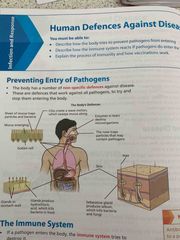
Back (Definition) |
|
|
Split the Non-Specific Defences into Physical and Chemical barriers. |
Physical: •Hairs in the Nose •Skin •Mucus •Platelets Chemical: •Tears •Stomach Acid •Antimicrobial Secretions (Sweat) |
|
|
Describe the Phagocytosis process. |
1)Microorganisms invade the body. 2)The White Blood Cell finds the Microorganisms and engulfs them. 3)The White Blood Cell ingests the Microorganisms. 4)The Microorganisms have been digested and destroyed. |
|
|
Describe the process in which Antigens help White Blood Cells locate, engulf and digest Antibodies. |
1)Antigens are markers on the surface of the Microorganism. 2)The White Blood Cells becomes sensitised to the Antigens and thus triggers the production of Antibodies. 3)The Antibodies then lock onto the Antigens. 4)This causes the Microorganisms to clump together, so that other White Blood Cells can engulf them. |
|
|
What is Immunity? |
The quick response which prevents a person from getting ill. |
|
|
What happens when someone receives a Vaccination? |
1) A weakened or dead strain of the Microorganism is injected into the person. Antigens on the Microorganism’s surface cause the White Blood Cells to produce Antibodies. 2) The White Blood Cells are capable of quickly producing the specific Antibody and remain in the bloodstream. |
|
|
What is Herd Immunity? |
When a large proportion of the population can be made immune to a Pathogen and thus the Pathogen cannot spread easily. |
|
|
What are Antibiotics? |
Medicines that kill Bacteria. |
|
|
What is MRSA? |
A strain of Bacteria which is resistant to Antibiotics. |
|
|
How can we reduce the rate at which resistant strains of Bacteria develop? |
•Doctors shouldn’t prescribe Antibiotics unless they are really need, for non-serious Infections or for Viral Infections. |
|
|
What is Immunity? |
The quick response which prevents a person from getting ill. |
|
|
What happens when someone receives a Vaccination? |
1) A weakened or dead strain of the Microorganism is injected into the person. Antigens on the Microorganism’s surface cause the White Blood Cells to produce Antibodies. 2) The White Blood Cells are capable of quickly producing the specific Antibody and remain in the bloodstream. |
|
|
What is Herd Immunity? |
When a large proportion of the population can be made immune to a Pathogen and thus the Pathogen cannot spread easily. |
|
|
What are Antibiotics? |
Medicines that kill Bacteria. |
|
|
What is MRSA? |
A strain of Bacteria which is resistant to Antibiotics. |
|
|
How can we reduce the rate at which resistant strains of Bacteria develop? |
•Doctors shouldn’t prescribe Antibiotics unless they are really need, for non-serious Infections or for Viral Infections. •Patients must complete their course of Antibiotics so that all Bacteria are killed and none survive to form resistant strains. |
|
|
What is Immunity? |
The quick response which prevents a person from getting ill. |
|
|
What happens when someone receives a Vaccination? |
1) A weakened or dead strain of the Microorganism is injected into the person. Antigens on the Microorganism’s surface cause the White Blood Cells to produce Antibodies. 2) The White Blood Cells are capable of quickly producing the specific Antibody and remain in the bloodstream. |
|
|
What is Herd Immunity? |
When a large proportion of the population can be made immune to a Pathogen and thus the Pathogen cannot spread easily. |
|
|
What are Antibiotics? |
Medicines that kill Bacteria. |
|
|
What is MRSA? |
A strain of Bacteria which is resistant to Antibiotics. |
|
|
How can we reduce the rate at which resistant strains of Bacteria develop? |
•Doctors shouldn’t prescribe Antibiotics unless they are really need, for non-serious Infections or for Viral Infections. •Patients must complete their course of Antibiotics so that all Bacteria are killed and none survive to form resistant strains. |
|
|
What is the Required Practical associated with Antibiotics? |
Back (Definition) |
|
|
What is Immunity? |
The quick response which prevents a person from getting ill. |
|
|
What happens when someone receives a Vaccination? |
1) A weakened or dead strain of the Microorganism is injected into the person. Antigens on the Microorganism’s surface cause the White Blood Cells to produce Antibodies. 2) The White Blood Cells are capable of quickly producing the specific Antibody and remain in the bloodstream. |
|
|
What is Herd Immunity? |
When a large proportion of the population can be made immune to a Pathogen and thus the Pathogen cannot spread easily. |
|
|
What are Antibiotics? |
Medicines that kill Bacteria. |
|
|
What is MRSA? |
A strain of Bacteria which is resistant to Antibiotics. |
|
|
How can we reduce the rate at which resistant strains of Bacteria develop? |
•Doctors shouldn’t prescribe Antibiotics unless they are really need, for non-serious Infections or for Viral Infections. •Patients must complete their course of Antibiotics so that all Bacteria are killed and none survive to form resistant strains. |
|
|
What is the Required Practical associated with Antibiotics? |

Back (Definition) |
|
|
What is Digitalis? |
A Heart drug that originates from Foxgloves. |
|
|
What is Aspirin? |
A Pain-Killer that originates from Willow. |
|
|
What is Penicillin? |
An Antibiotic discovered by Alexander Fleming from the Penicillin Mould. |
|
|
What are Monoclonal Antibodies? |
Antibodies which have been produced by a single Cell which had divided to make many Clones of itself. |
|
|
What can Monoclonal Antibodies be used for? |
•Pregnancy Tests - to bind to the Hormone HCG found in Urine during early Pregnancy. •In Laboratories to measure the levels of Hormones and other chemicals in Blood, or to detect Pathogens. •In Research to locate /identify specific Molecules in a Cell or Tissue by binding to them with fluorescent dye. •To treat some Diseases. |
|
|
What are the symptoms that a Plant may be Diseased? |
•Stunted Growth. •Spots on Leaves. •Areas of Decay. •Malformed (Abnormal) Stems or Leaves. •Discolouration. •The presence of Pests. |
|
|
How can you identify Disease in Plants? |
•Consulting a gardening manual/website. •Taking infected Plants to a lab, to identify a Pathogen. •Using testing kits, which contain Monoclonal Antibodies. |
|
|
What are Monoclonal Antibodies? |
Antibodies which have been produced by a single Cell which had divided to make many Clones of itself. |
|
|
What can Monoclonal Antibodies be used for? |
•Pregnancy Tests - to bind to the Hormone HCG found in Urine during early Pregnancy. •In Laboratories to measure the levels of Hormones and other chemicals in Blood, or to detect Pathogens. •In Research to locate /identify specific Molecules in a Cell or Tissue by binding to them with fluorescent dye. •To treat some Diseases. |
|
|
What are the symptoms that a Plant may be Diseased? |
•Stunted Growth. •Spots on Leaves. •Areas of Decay. •Malformed (Abnormal) Stems or Leaves. •Discolouration. •The presence of Pests. |
|
|
How can you identify Disease in Plants? |
•Consulting a gardening manual/website. •Taking infected Plants to a lab, to identify a Pathogen. •Using testing kits, which contain Monoclonal Antibodies. |
|
|
What is Tobacco Mosaic Virus (TMV)? |
A widespread Plant Pathogen. |
|
|
What does Tobacco Mosaic Virus do the Plant? |
•It infects Tobacco Plants, and many other Plants including tomatoes. •It produces a distinctive ‘Mosaic’ pattern of Discolouration on the Leaves, which reduces Chlorophyll content and affects Photosynthesis. •It affects the Growth of a Plant due to the lack of Photosynthesis. |
|
|
What is Rose Black Spot? |
A Fungal Disease. |
|
|
What are Aphids? |
Small Insects that feed from the Phloem, taking sugars away from the Plant. |
|
|
Provide examples of Deficiency Diseases. |
•Stunted Growth - caused by Nitrate Deficiency (as Nitrates are needed for Protein Synthesis). •Chlorosis - Magnesium Deficiency, because Magnesium Ions are needed to make Chlorophyll. |
|
|
What are the Physical Defences of a Plant? |
•Cellulose Cell Wall. •A tough-waxy Cuticle on Leaves. •Layers of Dead Cells around Stems, which fall off and take the Pathogen with them. |
|
|
What are the Chemical Defences of the Plant? |
•Antibacterial Chemicals, which are made by plants such as mint. •Poisons to deter Herbivores. |
|
|
What is Rose Black Spot? |
A Fungal Disease. |
|
|
What are Aphids? |
Small Insects that feed from the Phloem, taking sugars away from the Plant. |
|
|
Provide examples of Deficiency Diseases. |
•Stunted Growth - caused by Nitrate Deficiency (as Nitrates are needed for Protein Synthesis). •Chlorosis - Magnesium Deficiency, because Magnesium Ions are needed to make Chlorophyll. |
|
|
What are the Physical Defences of a Plant? |
•Cellulose Cell Wall. •A tough-waxy Cuticle on Leaves. •Layers of Dead Cells around Stems, which fall off and take the Pathogen with them. |
|
|
What are the Chemical Defences of the Plant? |
•Antibacterial Chemicals, which are made by plants such as mint. •Poisons to deter Herbivores. |
|
|
What is the equation for Photosynthesis? |
Carbon Dioxide (CO\/2) + Water (H\/2O) —> Glucose (C\/6H\/12O\/6) + Oxygen (O\/2) |
|
|
What are the Limiting Factors of Photosynthesis? |
•Temperature: - Increase In Temp = Increase In Rate. - As the Temp gets to 45°C Rate |

